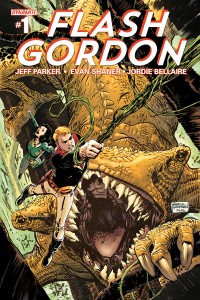
The King’s Watch mini-series was the relaunch vehicle for Dynamite’s treatments of the classic King Features Syndicate comic strip heroes: Flash Gordon, Mandrake the Magician and The Phantom. That series, also written by Flash Gordon writer Jeff Parker, establishes the status quo of Mongo invading Earth through portals that might be magic or might be an unknown science. At the end of the series, Flash Gordon, Dale Arden and Hans Zarkoff find themselves trapped on Mongo after shutting down the portals by which Ming can access Earth. That’s where Flash Gordon #1 begins.
The comic book Flash Gordon, as well as the movies and Filmation cartoon have all been centered around Mongo. Flash Gordon visiting another planet and liberating it from the evil emperor is a classic story, but Mongo was never a constant in the original comic strip the way it tends to be in the comics. For long stretches of the strip, Ming may not appear and Flash Gordon can be more of a space opera. Whenever a comic launches, Mongo is always the first story, though. It creates a bit of a burden as the creators have to tell the classic story in their own way and try to measure up with what’s gone before.
The major tweak here is the portals. Instead of being kidnapped to Mongo by Dr. Zarkoff (i.e., the only person who really understood the threat) in a rocketship that may or may not be able to get them home, Flash and company are there in a form of sacrifice. They’ve got the mysterious crystal that let’s Ming access the Earth and they’re on the run. There are also more portals. Instead of having the various kingdoms of Mongo, the kingdoms are different worlds accessed by the portals. Ming controls Mongo and then subjugates the other worlds. Issue one finds Flash and company spending time in Arboria, now a forest world, not just a forest kingdom. It opens up the scope a bit.
The characters are slightly tweaked. Instead of a professional polo player or ex-NBA player, Flash is now a daredevil trust fund baby. Younger, brasher, but a good excuse for him to have a background in stunt flying, extreme sports and the like — he’s just been a professional adrenaline junkie who ‘s hobbies have trained him well for the situation he’s fallen into.
Dale Arden is the least changed. Still a reporter, but much more assertive than in the original
Dr. Zarkoff is now a hard drinking scientist, perhaps not quite as crazy as in some versions, but definitely cranky.
The thing that sets this comic apart from other versions is the sense of fun. This is high adventure on strange new worlds, but it doesn’t take itself overly seriously past that they’re trying to prevent an invasion of Earth. Evan Shaner is further away from the Raymond/Williamson school of art than many who have worked on Flash Gordon. He’s using a looser style, closer to something you’d see in a French science fiction graphic album. More of the Roy Crane/Milt Canniff school than Raymond school, if you want to go back to the original 1930s sources.
This comic wins on flow and tone. There’s a decent amount of characterization, too, but Flash Gordon immediately jumps on the fun train and you’re along for the ride. A great change of pace comic. Dynamite’s been doing a lot with the classic pulp characters and in many (good) ways, this is the inverse of something like The Shadow or The Spider.
To be quite honest with you, although the next thing Jeff Parker should be doing be the sequel to his Interman graphic novel (the sooner you crank that out, the sooner I stop nagging you Jeff), I would welcome Jeff Parker’s Mandrake and Phantom.
Highly recommended for anybody looking for a fun romp with aliens and monster. If you want gritty and dark, this might not be for you (but gritty and dark isn’t exactly hard to find these days).





hey Todd,
Great post and review, I’m a big fan of Flash in many of his previous incarnation (some more than others), but I hadn’t picked this up yet, but now am very much looking forward to it.
Just a man,
Jayf
I pretty much agree with all the nice things said about the book here, but I think any recommendation of this book should stress that even though it’s called Flash Gordon #1, it is by no means the start of the story.
I was a bit dismayed when I realized that the big time jump between the three anecdotes that begin this issue and the “present” action that we join in media res was not going to be covered in this series; it was in fact story I was supposed to already know.
Parker does an all right job giving enough information for the reader to more or less follow what’s going on, but I was put off by under-explained stuff like the power crystals and the valley of portals and just what these three Earthlings were doing on an alien world in the first place. Frankly this article does a better job summarizing the events of the Kings Watch series than the comic does. Perhaps Dynamite could have included a summary of relevant preceding events on the inside front cover.
The downside of frequent relaunches and ongoing series packaged as mini-series is that when readers realize the “first issue” they just purchased is not in fact the start of the story, they feel cheated. If this had been issue 6 of a series I was jumping onto due to an enticing new art team, I’d have had different expectations and none of these problems.
Still, it’s a fun and gorgeous book. The Tothian art by Shaner, about midway between Chrises Samnee and Sprouse, is full of movement and expression, and Parker’s dialogue matches the fun and breezy tone.
Comments are closed.